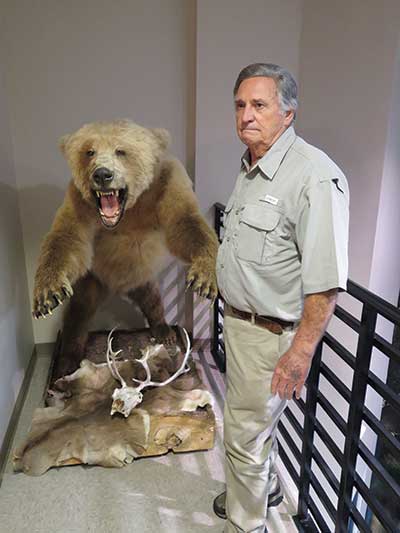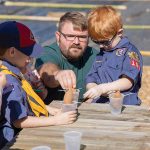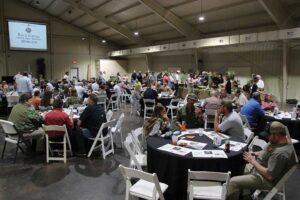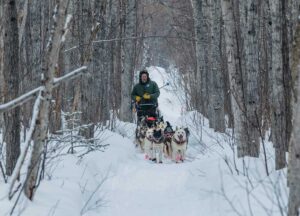
Three St. Clair men share their love of the hunt
Story by Elaine Hobson Miller
Photos by Graham Hadley
Some folks get their kicks riding race cars at top speed around an oval track. Others get a rush from parachuting out of airplanes, paragliding off high mountain peaks, or surviving an eight-second ride on a bull so mean he’d just as soon kill you as look at you.
Several St. Clair County men know another type of thrill, one that’s difficult for them to describe. It comes from taking down an elephant that he has tracked for miles across a South African plain, a lion that just roared from a brush-pile 12 feet away or an Alaskan brown bear that was about to invite him to dinner … as the entrée.
Between them, Rob Smith, Gordon Palmgren and Joe Wheeler have shot hundreds of birds and animals, large and small, from grouse to sheep and elephants. Each will tell you that it’s not the kill that provides the thrill. It’s the sighting and tracking of these animals that give these guys that rush of adrenalin, a rush so powerful they’re willing to spend thousands of dollars to experience it over and over again. For them, pulling the trigger is actually anti-climactic.
“After you shoot, it’s all over,” says Smith. “There’s a tinge of sadness because you’ve taken this magnificent animal’s life.”
All three men have been hunting most of their lives. Two of them were taught by a female member of their family. Smith, for example, went on his first hunt with his grandmother when he was 10 years old. “She was one of the last of the old pioneer women,” he says. “She could do anything.” They hunted rabbits and squirrels together around Tallahassee, Fla., where he grew up. They usually took their prey home and ate it. “Man has always hunted,” he says. “It’s part of our basic instinct. As you get older, you start hunting deer here in the South. I progressed.”

bear hunt in front of the animal.
Smith, who started Advance Machinery in 1985 and retired 20 years ago, has been hunting big game for more than 30 years. His first international hunt was in Mongolia in 1990, and netted him an ibex, a type of wild mountain goat distinguished by the male’s large, recurved horns, and a six-point elk. Their cape mounts (head and shoulders) hang on one side of his den fireplace, while a 22-point red stag from New Zealand hangs on the other side.“You only count one side of the head for the points on an elk,” he says. “You count both sides for a red stag.”
Throughout the house are mounts of many of the animals Smith has taken. Above the fireplace is the skull of a moose, an animal whose size is measured by the distance between the widest points of its “palms,” the two wide, flat antlers. This one measures 55 inches. Mule deer from Wyoming and Montana flank the doorway into his kitchen. But the dominant animal in the den is the nine-foot-tall brown bear from Alaska in the corner. “He was standing like that when I shot him, looking at a herd of caribou,” Smith recalls. “He didn’t know what hit him.” He has the creature’s skull, with worn teeth indicating he was about 28 years old. “His teeth were deteriorating, so he would not have lived through another winter,” Smith says.
Hunting has taken him all over the North American continent and around the world. He has shot Arctic caribou on Victoria Island, which is above the 60th parallel and as far north as people actually live. “It was 20 below zero there, dangerously cold,” he says of that trip. He has taken white-tailed deer in Alabama, Dall sheep, bears and mountain goats in Alaska, Russian wild boar in South Carolina, tahr (related to goats and sheep), sika deer and chamois (a species of goat-antelope) in New Zealand.
“You’ve got to be physically fit to track the mountain animals,” says Smith, who is 69. “I was much younger, and my knees were in better shape when I killed those. You might climb 5,000-6,000 feet up a mountain. You’re carrying a backpack and a rifle. I have weights and an exercise machine in my basement, and I work out almost every day. But I don’t climb mountains anymore.”
He considers the elephant one of the most physically demanding beasts to hunt. “You have to walk 10-12 miles a day for two to three weeks, sometimes longer,” he says. “You may track a herd for two or three days, catch up and find no bulls big enough to take. Then you start all over again.”
His trophy room contains several photos of game that were too big to mount, like the Indian buffalo from Argentina and the water buffalo he took in Australia. In 1993, the state of Montana sent him a plaque for shooting the second largest antelope killed there at that time. There’s a musk ox fur stretched over the pool table, and 12 mounts hang on the walls. “You mount them to honor the animal, to remember them,” he says. Smith uses Stone Taxidermy of Leeds for most of his mounts.
He has hunted Africa and Australia for the last 12 years, because he likes the challenge of tracking dangerous game (buffalo, elephant, lion, hippopotamus, crocodile and leopard). “The animal has as good a chance to take you out as you have to get him,” he says. His primary prey now are the elephant and the cape buffalo. He has a mount of the latter over the doorway from his foyer to his trophy room. “The rhinoceros is now on the endangered species list due to poaching, so we can’t hunt them,” he says. “Poachers kill them for the horns, sell them to the Asians, who grind them up and use them as an aphrodisiac.”
Poachers hunt in secret and leave the carcasses, but legitimate hunters donate the meat to local villagers, usually through the outfitters who organize the hunts. “When do-gooders start hollering, ‘Why would you shoot a magnificent animal like the elephant,’ I say it’s no different than shooting a cow,” Smith explains. “That elephant will feed a whole village for weeks or months.” He says it’s against the law for villagers to shoot the elephants because the government makes money off the trophy fees. “There’s not an animal in this house that wasn’t eaten, except for the bear. Brown bears are inedible.”
Even in Alaska, you can’t just leave the meat where you drop the animal. In some cases, Smith has had it processed and shipped home from Alaska, but usually he packs it out. “It took me four days to backpack all the meat out (of camp) when I took that big moose that’s hanging over the fireplace,” he says. “You can’t drive a truck up to get it. The outfitter donated it to the indigenous people and to charities.”
Normally Smith does two or three international hunts a year. Much of the money spent on hunts in the U.S. and abroad goes into animal conservation. “Even in this country, the biggest part of conservation money comes from hunters’ fees,” he says. “Besides, nature has to have checks and balances. Most animals get diseases from interbreeding. If they have no natural predators, they starve.”
Unlike Smith, Gordon Palmgren won’t shoot an elephant, unless it’s a rogue that’s running amuck through villages and fields. “I don’t want to disrupt their family unit,” he says. “They are special.” His wife, Sharla, does not want him to shoot a giraffe. Those are about the only two big-game animals not on display at his office.
In fact, the conference room at Gordon Palmgren Inc., which lays fiber-optic cables, looks like a natural-history museum. Murals on the back and front walls depict an African plain and the face of a rugged mountain, respectively. Painted by Springville’s Joy Varnell (see the October/November 2019 issue of Discover), they form backdrops that make the full-body animals appear to be in their natural habitats. Elephants and a giraffe are painted into the African mural, along with Palmgren’s two sons, depicted as youngsters peeking from behind a tree.
“I took Dane, who is now 30, to Africa when he was younger,” says Palmgren. “He shot a (large species of antelope) when he was 10. Travis, 35, is an artist who has never hunted, but he’ll come up here and draw pictures of the animals.”
Other animals in front of that mural include several types of antelopes, such as a sable, along with two steenboks, two duikers and a musk ox. There’s also a zebra, a lion and lioness, an impala, wart hogs and forest hogs, a bush buck (another type of antelope), a pair of monkeys, some baboons and a 14-foot-long crocodile. An Arizona javelina (type of wild boar) is placed incongruously amid all those African animals, but he doesn’t seem to object. The straw-grass at the base of many mounts has been chewed short by Sylvester, the office’s live feline mascot.
On another African wall are more full-body monkeys and the cape mounts of a rhinoceros, cape buffalo and another sable antelope. “The Safari Club International has a system of scoring your kills by length of their horns,” Palmgren says. “There are three levels: bronze, silver, gold. That sable is the only animal I’ve shot that’s in a (record) book. For a year it was No. 7 in the world.”
A lot of hunters won’t shoot an animal if it’s not a huge, gold-medal trophy, but Palmgren doesn’t hunt to get into record books. “I do it for the fun, the challenge, to see different places,” he says. “I’ve seen a lot of the world.”
On the other two walls hang dozens of cape mounts, such as spiral-horned kudu, a red hartebeest (African antelope), a gemsbok (another type of South African antelope), a moose from British Columbia, several elk out of Colorado, a bison from New Mexico, a water buffalo from Venezuela, a caribou from Greenland, a mountain goat from British Columbia, a tahr and a chamois from New Zealand. Still another wall has full-mounted mountain goats, a tahr and a chamois standing on ledges that jut out from the wall.
His mounts spill over into his office and lobby, too, including a full-body mount of an aoudad (Barbary sheep) shot in Texas and a nyala (spiral-horned antelope of southern Africa). The latter stands in a corner under a pencil drawing of a tiger done by Travis. A zebra skin is displayed on another wall. In his office stands an eight-foot-tall blonde brown bear. Who knew that brown bears are a species that come in various colors? Or that the grizzly is a subspecies of the brown bear? “Grizzlies are inland, whereas brown bears are coastal,” Palmgren points out.
He uses Capps Taxidermy in Demopolis to preserve his trophies. “Mounting them in foreign countries, you don’t know the quality, he says. “It’s not as good as here. Shipping home life-size animals is especially high, so the hide and horns are all you take home to the taxidermist. Generally, you only mount the cape, which is from front shoulder forward. To me, though, with certain animals, you miss so much with just the cape.”
Like Rob Smith, Palmgren, 69, started hunting as a child. His mother gave him a .410 shotgun when he was 12. “We used to hunt squirrel and other small game together,” he says. A big-game hunter for 25 years, he bought his first trip to Africa at a Safari Club International convention in Las Vegas in 1996. He has been to Africa five more times since then. “It’s like potato chips, you can’t do just one,” he says. “It’s such a thrill. It’s the chase and the challenge. You will go back.” He hasn’t been there this year but has spent his spare time developing a piece of hunting property he bought in St. Clair County.
In African countries, governments there require that you have a local guide, called a professional hunter there. Hunters go out in groups that include trackers and skinners. “The 10-day rate varies according to exclusivity of the animal and his dangerousness,” Palmgren says. “It can be $1,500 per day to $3,000-$4,000 for more dangerous animals, such as lions and elephants. Every animal has a trophy fee attached, too. Supply and demand determine those. There are also government fees.”
Although hippopotamuses kill more people than lions in African countries, tracking a lion still is a dangerous proposition. Palmgren found that out the hard way on the trail of a lioness in South Africa. “I had spotted her, then she got away, and I was using binoculars to spot her again,” he recalls. “I walked by a room-sized brush pile, heard growling, then a roar from 12 feet away. She was in that brush pile. I shot her, but I also found out how I would react to a dangerous situation. I didn’t think I would ever quit shaking.”

Joe Wheeler had a similar experience with a blonde brown bear, but it was much more personal than Palmgren’s. The bear was trying to snare him for her lunch and managed to sink one of her powerful claws into his hand.
“I was watching some wolverines and got a funny feeling that something was watching me,” he says. “I turned around and she was in attack mode. I shot her in the mouth, which knocked her down. She got up, and I got off a second shot into her neck, and she went down again.”
As he was reloading his rifle, her left claw dug into his right hand. Working from instinct, he turned around in the opposite direction to avoid that claw dragging through a ligament. As he did, she slapped him across the back with her other paw. He got off a shot to her heart. She ran 60 yards, forcing him to track her. She was dead when he got to her. “That’s the only female bear I’ve ever shot,” he says. “She’s mounted in the same position as when I first saw her.” She’s crouched in a corner at the top of the stairs in his Gun South Inc. (GSI) office in Trussville.
In a hallway of the first floor, he has another brown bear, a wolf snarling on a tabletop, bobcats fighting over a pheasant and a pair of Alaskan wolverines. “Pound-for-pound, wolverines are the most vicious animal alive,” Wheeler says. (Wolverines resemble small bears but are actually the largest member of the weasel family.) He has a wolf-skin rug stretched out on a wall in the office at GSI. On another wall is a pair of ptarmigan(type of grouse) he shot in Sonora, Mexico.
Wheeler, 77, started hunting rabbits, quail and squirrels with his uncle as a kid. He killed his first deer when he was 14. It had eight-points. “I went to Bud Jones’ house (in Tallapoosa, Ga.) and skinned it there in his back yard, and he mounted it,” Wheeler says. “I still have that mount. It’s probably my favorite.”
He made his first trip to Alaska in 1972, killing a caribou and a moose. He has gone twice a year ever since, sometimes to hunt, sometimes to fish. In addition to bears, wolves and wolverines, he has killed siska deer, pocka squirrels (similar to prairie dogs) and Arctic hare. Due to the pandemic, he probably won’t return this year. He has taken his two brothers, his two stepsons, and several other St. Clair County men with him on several trips. In fact, he took Gordon Palmgren on his first hunt to Alaska and got him his first bear.
“I was a registered guide in Alaska from 1984 to 1998 or 1999,” he says. “Licenses were for five years when I started, but they changed that to three years, and I didn’t get the notice in time, so I accidentally let my license expire. I would have had to re-test, and I didn’t want to do that.”
An Alaskan hunt usually lasts 17 days and involves a lot of walking. “If it’s a bear hunt, you’ve got to find the bear with a spotting scope,” Wheeler says. “You can see for eight miles through the scope, and if you spot one within five miles, you go after it.”
He has hunted big game in Canada, Montana, Colorado, British Columbia, Alaska, Texas, Mexico and parts of New England. He has been wing-shooting (bird hunting) 15-16 years in a row in Argentina, Nicaragua and Honduras. He has shot spur-wing and Magellan geese in the Yucatán Peninsula, and jack rabbits in Argentina so big that if laid across a horse they would drag the ground. “I tracked one running at 64 mph one night,” he says. “I could not bring it back to mount because of some disease.”
He used to have a lot of mounts in his Pell City Steakhouse, but the women employees there prefer seeing historic photos of the Pell City area, so he obliges them.
In the gunsmithing room at GSI, a wholesale gun dealership, Wheeler has the capes of a mouflon sheep from Austria, an elk from Saskatchewan taken with a bow, and a caribou his stepson, Danny Spann, shot in Alaska.
“The tips of the mouflon’s horns were worn off from where he rubbed them on rocks so they wouldn’t poke him in the eyes,” Wheeler says. “It’s called ‘grooming.’”
The elk is called a 7×7 because it has seven points on each side of its head.
“Only one caribou in 10,000 has a double shovel (flat, front points), and he’s shot three,” Danny says of Wheeler. “We were fortunate to see tens of thousands of the Mulchatnaherd of caribou in Alaska.”
Hunters in Alaska are required by the state’s Fish and Game Commission to pack out the meat or face a fine and the possible loss of a guide’s licenses. “One time we had all the meat in elk bags and a bear got some of it in camp overnight,” he says. “Fish and Game did not want to accept that we hadn’t hauled it all out, but I had made photos before and after.” Like Rob Smith and Gordon Palmgren, he always gives away the meat. “We killed 125 geese in one day in Nicaragua,” he recalls. “We put them on a wall in the town square, and they were gone by the next day. The natives got all of them.”
Asked what he likes about hunting, he cites being “out in nature, seeing things, making a lot of friends.” Take the bird boys who pick up the fowl that hunters shoot. “We (he and his friends) have gotten to see them grow up in Nicaragua,” Wheeler says. “We do a lot of personal things for them. We’ve sent them money for school supplies, candy, bought them shoes.”
He also likes teaching young boys to shoot, the way his uncle taught him, and he taught his stepsons. He’ll even take friends’ grandsons and nephews hunting, showing them how to track, read the signs, keep quiet and still, be patient and to enjoy the outdoors the way he does.
Wheeler probably will miss his 2020 trips to Alaska, thanks to COVID-19. He will still be able to hunt birds and small game on his own property in St. Clair, where he has a hunting club. After all, as he, Smith and Palmgren keep emphasizing, it’s not about the kill or the size of the trophy. It’s all about the hunt.















